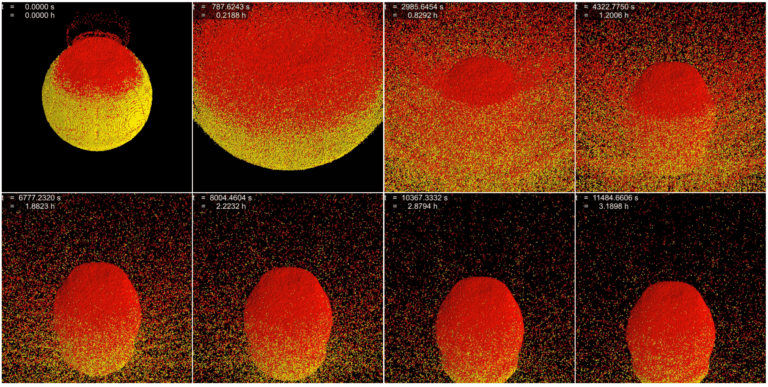It’s become something of an action movie cliche: an asteroid is hurling towards Earth, its impact will cause a mass extinction, and the only hope for humanity is a ragtag group of astronauts and average Joes who will fly to the asteroid and blow it to pieces using nukes. The idea has been explored so many times by Hollywood that it seems like this is actually something space agencies have planned.
And in truth, they are, though the execution may be a little more sophisticated. For decades, space agencies have considered various methods for destroying asteroids that threaten Earth. But according to a new study led by researchers from John Hopkins University, incoming asteroids may be harder to break apart than we thought.
The study, which recently appeared online and is awaiting publication in the March 15th issue of Icarus, was led by Charles El Mir – a recent PhD graduate from the JHU Department of Mechanical Engineering. He was joined by K.T. Ramesh (the director of the Hopkins Extreme Materials Institute) and Derek Richardson, a professor of astronomy at the University of Maryland.
 A frame-by-frame showing how gravity causes asteroid fragments to reaccumulate in the hours following impact. Credit: Charles El Mir/Johns Hopkins University
A frame-by-frame showing how gravity causes asteroid fragments to reaccumulate in the hours following impact. Credit: Charles El Mir/Johns Hopkins UniversityFor the sake of their study, the team relied on a new understanding of how rocks fracture combined with a new method of computer modeling to simulate asteroid collisions. As El Mir described in a recent JHU press release, what they found was rather surprising:
“We used to believe that the larger the object, the more easily it would break, because bigger objects are more likely to have flaws. Our findings, however, show that asteroids are stronger than we used to think and require more energy to be completely shattered.”
One of the problems of knowing how an asteroid would respond to any attempt to blow it up has to do with scale. While scientists understand how rocks behave on smaller scales (such as hand-sized stones or boulders), city-sized objects like a Near-Earth Asteroid (NEA) present a whole different set of challenges.
In the early 2000s, another team of researchers had created a computer model to determine what kind of impacts were necessary to destroy an asteroid. Based on factors like mass, temperature, and composition, they determined that an asteroid that was 1 km (0.62 mi) in diameter would need to strike an asteroid 25 km (15.5 mi) in diameter at a velocity of no less than 500 km/s (310 mps) to destroy it.
For their study, El Mir and his colleagues entered the same scenario into a new computer model called the Tonge-Ramesh model, named in part for co-author K.T. Ramesh who helped create it. This model is able to account for more detailed, smaller-scale processes that occur during an asteroid collision – such as the limited speed of cracks in the asteroids
The simulation they then ran occurred in two phases – a short-term fragmenting phase that covers the first few seconds after the impact followed by long-term re-absorption phase where gravitational forces pull the fragments back together over the course of hours. What they found was that the initial impact formed a crater and caused millions of cracks to form and propagate through the asteroid.
However, contrary to what was previously thought, the impact didn’t result in the destruction of the asteroid. Instead, the propagated cracks reached all the way to core, which then exerted a strong gravitational pull on the fragments during the second phase of the simulation. In the end, the asteroid managed to retain its integrity and the fragments that broke loose were merely redistributed over the damaged core. As El Mir explained:
“It may sound like science fiction but a great deal of research considers asteroid collisions. For example, if there’s an asteroid coming at earth, are we better off breaking it into small pieces, or nudging it to go a different direction? And if the latter, how much force should we hit it with to move it away without causing it to break? These are actual questions under consideration.”
This study could go a long way towards informing future asteroid-impact mitigation strategies. By knowing what kinds of impactors and forces are not sufficient for breaking up an asteroid, mission planners will have accurate parameters to work with. This knowledge could also have extensive applications with asteroid mining, letting drillers know exactly how asteroids of various sizes will respond to drilling and extraction from.
And as Ramesh indicated, this information will have all kinds of practical uses that can’t come soon enough:
“We are impacted fairly often by small asteroids, such as in the Chelyabinsk event a few years ago. It is only a matter of time before these questions go from being academic to defining our response to a major threat. We need to have a good idea of what we should do when that time comes – and scientific efforts like this one are critical to help us make those decisions.”
In sum, humanity is not doomed in the event that an asteroid starts hurtling towards Earth, just better informed. And that will go a long towards making sure we remain safe from major impacts in the future. As an added bonus, now when Hollywood decides to do another disaster movie featuring an asteroid, they’ll be able to get the physics right!
